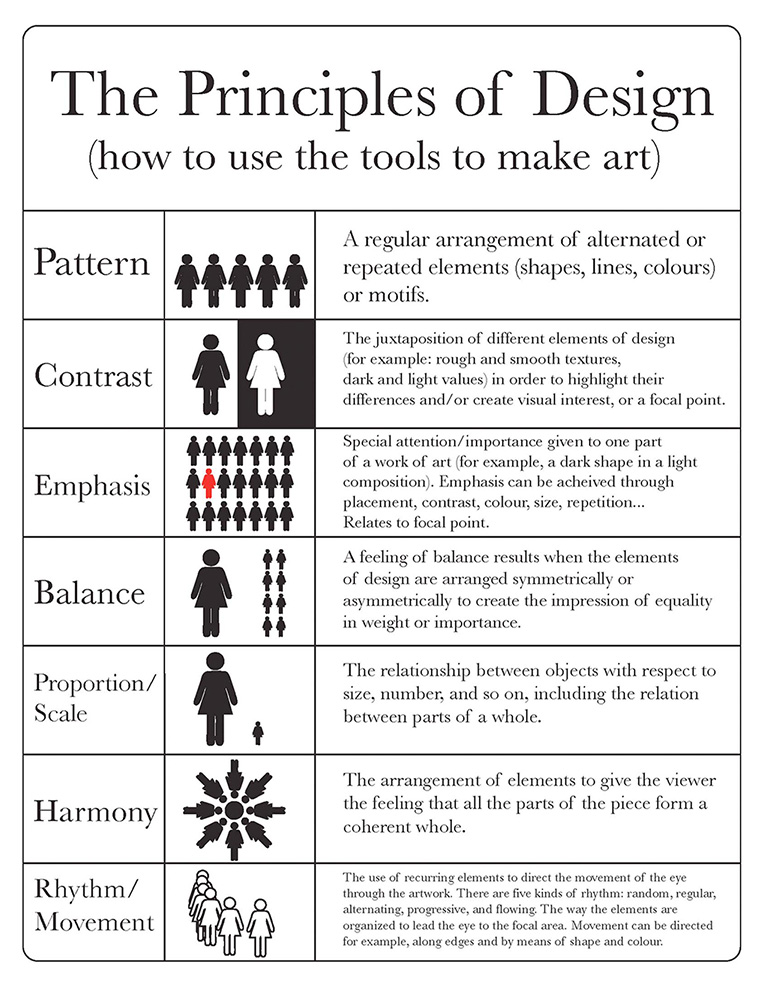The 10 Principles of Art: Definitions and Examples

Another way to think about these design principles is that they express a value judgment about a composition. For example, when we say a painting has “unity” we are making a value judgment. We might also say that too much unity without variety is boring and too much variation without unity is chaotic.
The 11 Principles of Design and Art [Infographics Included]
Create balance in art symmetrically, asymmetrically, or radially. The factual information provided is accurate, does not contain errors and is sensitive to world views. Enjoyable read and could be used alone or with supplemental material.
The Key Elements & Principles of Visual Design
Movement can be harnessed to distract, direct, and pull the viewer’s gaze around a design. A savvy artist can control this entire process by using subtle cues (particularly with lighting and perspective), like using lines to create directional cues and make images feel more alive. Where objects in real life carry physical weight, elements in design carry visual weight.
Conceptual Art – An Exploration of the Conceptualist Art Movement
Small doses of variety are helpful to ensure that your customers are not lulled to sleep. Rhythm defines the structure and discipline of repetitions to create desirable movements. It can also set the mood for the communications you are developing. If you want your customer to develop a sense of energy and youthfulness through your design, you can create a fast rhythm where elements swiftly change in style and nature. White space works well in corporate communication and aesthetic designs created for special occasions.
We will aim to provide the differences between the two while also intentionally applying the terms interchangeably. The goal of treatment for ART-experienced patients with virologic failure is to establish virologic suppression. The management of ART-experienced patients with virologic failure often requires expert advice to construct virologically suppressive regimens. If HIV RNA suppression is not possible with currently approved agents, consider the use of investigational agents through participation in clinical trials or expanded/single-patient access programs.
It is true that many of the artworks and artists are familiar and part of a standard canon of Western art and its cultural touchstones. However, each chapter also contains references to non-Western art, and a cross-cultural approach is evident throughout the book, not only in isolated chapters. The PDF form with live links to websites and on-line resources was easy to use.
Monochromatic palettes utilize tints, tones, and shades of a single color. With radial balance, like in the example of radial balance below, one can imagine the artwork as equal pieces of a pie. In this example of symmetrical balance in art, each animal on the left has its equal counterpart on the right. The colors are not exact, but it is still considered symmetrical balance. Ancient Egyptian artists are well-known for their use of hierarchical scale. In this example of hierarchical scale in art, the artist shows the man as largest (most important) and the child smallest (least important).
How to Teach Design Principles to Artificial Intelligence (AI) - G2
How to Teach Design Principles to Artificial Intelligence (AI).
Posted: Mon, 26 Aug 2019 07:00:00 GMT [source]
Unity and Harmony
The Principles of Art Gensler – Common Edge - Common Edge
The Principles of Art Gensler – Common Edge.
Posted: Mon, 17 May 2021 07:00:00 GMT [source]
Like contrast, emphasis is when an artist uses a combination of techniques to draw the viewer’s attention to a crucial component of their art piece. Harmony is a bit vague compared to some of the other principles. Generally speaking, it refers to how well all the visual elements work together in a work of art. Elements that are in harmony should have some kind of logical progression or relationship. If there is an element that is not in harmony with the rest of an artwork, it should stick out and be jarring to look at. Art is a notoriously gray area when it comes objectively defining what is great and what is not.
Unity and Variety
The order is logical and terraced to build upon previously presented ideas and themes. Would function well as a “pick and choose” text for a introductory art course or a course designed for non-majors. The textbook is accurate and without bias according to my reading. Table of contents, key terms and “Test Yourself” sections are comprehensive and helpful from a teaching perspective. The book was presented in chapters that worked well in the course and for what I needed. Seemed to work well and present ideas and concepts that were relevant to for my students.

Patterns allow us to explore the deliberate repetition of specific shapes and colors. When this becomes an area of emphasis, even mathematics can come into play as in the incredible visuals in Islamic art. Forms and shapes are defined by the amount and quality of available light. When there is ample light, there may be many identifiable tones on visible forms.
Variety is basically about different elements in a composition that gives it its uniqueness. It provides a continuing contrast, or some sources describe “chaos”, which engages the viewer and maintains a level of interest and awe for the composition; it evokes emotion and expression. Rhythm is created through repeated elements and this creates movement. Earning his doctorate was a five-year journey for Williams, during which he consistently worked full-time. Not content to sit on his laurels, however, he is already thinking about what will come next.
Comments
Post a Comment